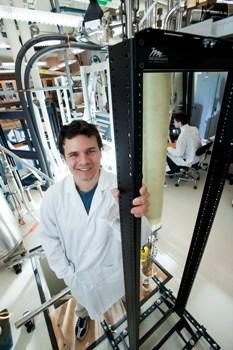MIT researchers have revealed that graphene can generate electric current in uncommon ways when sparked by the energy of light.
 Pablo Jarillo-Herrero. Credit: Len Rubenstein
Pablo Jarillo-Herrero. Credit: Len Rubenstein
The finding paves way to a novel method for electricity production from sunlight and enhances night-vision systems and photodetectors.
Pablo Jarillo-Herrero, one of the MIT researchers, stated that scientists had already found the current-producing effect of graphene but they believed that it was caused by a photovoltaic effect. However, the MIT scientists observed that by focusing light on a graphene sheet makes it to have two regions with dissimilar electrical characteristics, which in turn generates a difference in temperature and eventually produces an electrical current.
Jarillo-Herrero and his team determined that illuminating graphene using a laser, results in variable heating of the material. The light heats graphene’s electrons that transmit current, but it does not heat the carbon nuclei lattice, which makes the backbone of the material. This temperature difference called as ‘hot-carrier’ response is responsible for production of the electricity flow.
Jarillo-Herrero stated that the cause for the uncommon thermal reaction of graphene is due to its strength, which makes it to intake ultra-high energy to vibrate its carbon nuclei lattice, resulting in the transfer of very minimal amount of heat of the electrons to the lattice. Graphene finds use in numerous applications, he said. It can be used a better photodetector as it generates current in an unusual method, he said. As it functions well in the infrared light range, it can be used for the production of sophisticated detectors and night-vision systems for advanced astronomical telescopes, he added.
According to the finding, graphene can also be used to detect biologically significant molecules, including food contaminants, disease vectors and toxins, most of them produce infrared light during illumination. Graphene can be comparatively inexpensive to other detector materials such as semiconductors. As it responds to an extensive range of wavelengths, graphene can effectively collect solar energy, said Jarillo-Herrero. However, further research will be required, as it is still not clear that the material can efficiently produce energy, he added. The factors that can enable graphene faster or better will now be the focus of further research, he added. The Air Force Office of Scientific Research backed the research work, which also received funds from the Packard Foundation and the National Science Foundation.